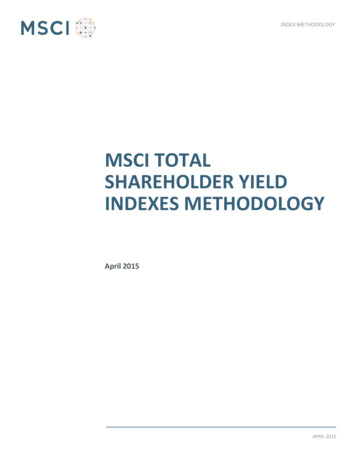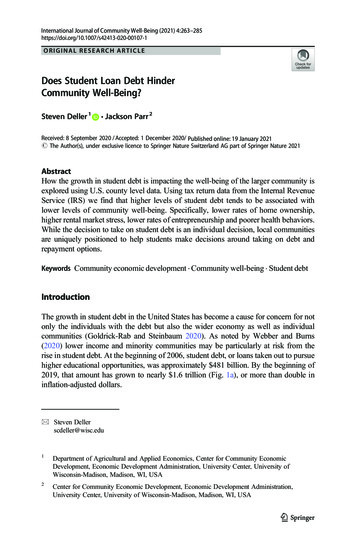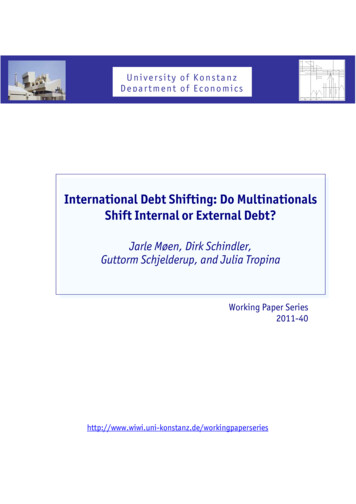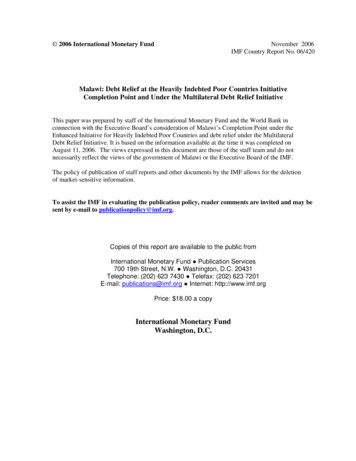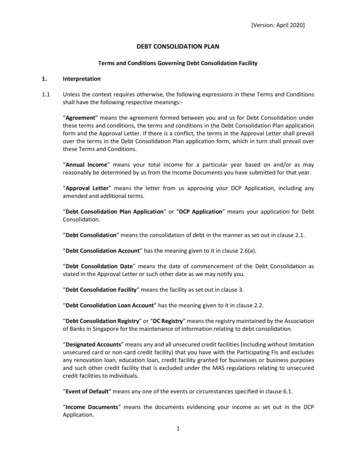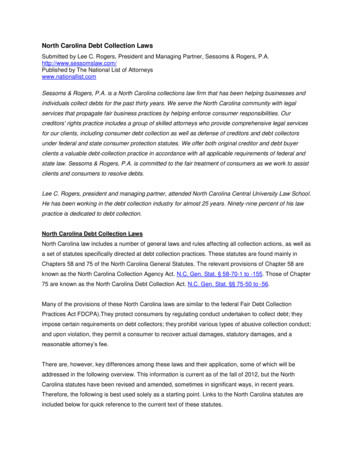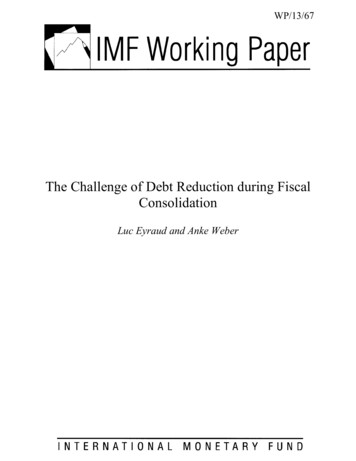
Transcription
WP/13/67The Challenge of Debt Reduction during FiscalConsolidationLuc Eyraud and Anke Weber
2013 International Monetary FundWP/13/ IMF Working PaperFiscal Affairs DepartmentThe Challenge of Debt Reduction during Fiscal ConsolidationPrepared by Luc Eyraud and Anke Weber1Authorized for distribution by Martine Guerguil0DUFK 2013This Working Paper should not be reported as representing the views of the IMF.The views expressed in this Working Paper are those of the author(s) and do not necessarilyrepresent those of the IMF or IMF policy. Working Papers describe research in progress bythe author(s) and are published to elicit comments and to further debate.AbstractStudies suggest that fiscal multipliers are currently high in many advanced economies. Oneimportant implication is that fiscal tightening could raise the debt ratio in the short term, asfiscal gains are partly wiped out by the decline in output. Although this effect is not longlasting and debt eventually declines, it could be an issue if financial markets focus on theshort-term behavior of the debt ratio, or if country authorities engage in repeated rounds oftightening in an effort to get the debt ratio to converge to the official target. We discusswhether these problems could be addressed by setting and monitoring debt targets incyclically-adjusted terms.JEL Classification Numbers: C54, E62, H60Keywords: fiscal consolidation, fiscal multipliers, public debtAuthors’ E-Mail Addresses: leyraud@imf.org; aweber@imf.org1This paper received useful comments and suggestions from Swarnali Ahmed, Jochen Andritzky, NathanielArnold, Aqib Aslam, Benjamin Carton, Carlo Cottarelli, Lorenzo Forni, Dmitry Gershenson, Phillip Gerson,Emine Hanedar, Martine Guerguil, Kotaro Ishi, Bernd Lucke, Esther Perez Ruiz, Alasdair Scott, Ikuo Saito,Justin Tyson, and Yingbin Xiao. It also benefited from the discussions during the surveillance meeting seminarheld at the IMF on April 10, 2012, and the joint IMF-OECD Workshop on December 12, 2012 (OECD, Paris).Raquel Gomez provided excellent research assistance.
2I. INTRODUCTIONWith large fiscal adjustments underway in many advanced economies, there is a renewedinterest in the effects of fiscal policy on economic activity. Surprisingly, the feedback effectfrom growth to fiscal aggregates, and in particular to public debt, has received less attention.This issue is becoming more pressing as debt reduction has become a key target of fiscalpolicy in a number of advanced economies.This paper examines the impact of fiscal consolidation on debt dynamics.2 We first analyzethe size of short-term fiscal multipliers, which are key parameters in the nexus between fiscalconsolidation, growth, and debt reduction. We show that in the current environment,multipliers for advanced economies could be close to 1, significantly above the averagemultiplier found in the literature before the recent financial crisis. The negative impact offiscal tightening on economic activity in the near term is indeed amplified by some featuresof the current environment, including the proportion of credit-constrained agents, thedepressed external demand, and the limited room for monetary policy to be moreaccommodative.With multipliers close to 1, fiscal consolidation is likely to raise the debt ratio in the shortrun in many countries. Although the debt ratio eventually declines, its slow response to fiscaladjustment could raise concerns if financial markets react to its short-term behavior. It mayalso lead country authorities to engage in repeated rounds of tightening in an effort to get thedebt ratio to converge to the official target. Not explicitly taking into account multipliers orunderestimating their value may lead policymakers to set unachievable debt targets andmiscalculate the amount of adjustment necessary to bring the debt ratio down.These findings do not imply that fiscal consolidation is undesirable or that debt isunsustainable. The short-term effects of fiscal policy on economic activity are only one of themany factors that need to be considered in determining the appropriate pace of fiscaladjustment. Our results rather highlight the need for care in projecting the debt path and thebenefits of setting and monitoring debt targets in cyclically-adjusted terms.Our paper contributes to the literature in several ways. First, it formalizes the relationbetween fiscal adjustment and debt dynamics by explicitly taking into account how thisrelation is influenced by fiscal multipliers. Second, it provides empirical evidence supportingthe hypothesis that fiscal consolidation can raise the debt ratio in the short-term. Third, to ourknowledge, it provides one of the first extensive analyses of the “cyclically adjusted debtratio” concept.3The paper is organized as follows: Section II reviews the literature and discusses the23This analysis builds on and extends Eyraud and Weber (2012).The European Commission has analyzed a similar concept in the context of the discussions on the debtreduction benchmark (see EC, 2011).
3analytical framework, including the fiscal multiplier assumptions. Sections III and IVanalyze the impact of fiscal consolidation on debt dynamics through simulations andeconometric estimations. Section V draws policy implications, and in particular, evaluatesthe relevance of debt indicators in cyclically-adjusted terms. Section VI concludes.II. FISCAL CONSOLIDATION AND DEBT REDUCTION: THE ANALYTICAL FRAMEWORKA. Literature ReviewAlthough debt dynamics have been the focus of many theoretical and empirical papers (inparticular those dealing with fiscal sustainability, like Escolano 2010), few have specificallyanalyzed the effect of fiscal policy on the debt ratio, probably because the existence of anaccounting relationship suggests that the relation between these variables is straightforward.From a conceptual point of view, Gros (2011) and the European Commission (2012) developa framework akin to ours. Gros (2011) shows that austerity could be self-defeating andincrease the debt ratio in the short-term. However, Gros does not examine the impact ofrepeated episodes of tightening; neither does he explore the implications of multiplierpersistence—two key factors affecting the debt response, as we show below.Model-based simulations are an important instrument to assess the effect of fiscal policy onthe debt ratio. Many dynamic stochastic general equilibrium (DSGE) models incorporate thegovernment budget constraint and report fiscal multipliers on this basis, while explicitlytracking the behavior of the public debt-to-GDP ratio. For instance, Forni and others (2009)analyze the response of macro variables to a range of fiscal shocks in the Euro Area usingquarterly data. They find that following a 1 percent increase in government purchases ofgoods and services, the debt ratio initially declines by about 1 percent before increasing fromthe fourth quarter onwards. The response is symmetric, so that in case of a negative shock togovernment spending, the model would predict an initial increase in the public debt-to-GDPratio.Until recently, empirical papers analyzing the impact of fiscal policy on output have omittedthe debt variable. Favero and Giavazzi (2007, 2009) have shown that this omission mayresult in incorrect estimates of the dynamic effects of fiscal shocks. They argue that by nottaking into account the government intertemporal budget constraint, previous studies mayhave assessed the effects of fiscal policy along unsustainable debt paths. They incorporatedebt dynamics into a structural vector autoregression (SVAR) for the United States, allowingfor the possibility that taxes, spending and interest rates respond to the debt level. They showthat fiscal multipliers differ in models with and without debt feedbacks. Building on theFavero and Giavazzi framework, Cherif and Hasanov (2010) use generalized impulseresponses to analyze macro variable dynamics, and find that positive shocks to the primarysurplus reduce public debt. Ilzetzki (2011) extends the analysis to a sample of developingcountries but concludes that in most countries, including a debt feedback effect does notchange the size of fiscal multipliers significantly.
4B. Some Unpleasant Fiscal ArithmeticThe debt ratio does not decrease one-for-one with fiscal tightening.4 The reason is that fiscaltightening reduces GDP in the near-term—an effect referred to as the “fiscal multiplier.”5Lower GDP in turn reduces the denominator of the debt ratio and also partly offsets theconsolidation effort, thus affecting the numerator (automatic stabilizers). This may mitigateor even eliminate the direct tightening effect, at least in the short run.The mitigating effect is stronger if fiscal multipliers, the initial debt ratio, and/or automaticstabilizers are larger (see Appendix 1 for detailed formulas).6 For instance, a 1 percent ofGDP consolidation relative to the baseline should reduce the debt ratio in the first year by: debt GDP1001In a country with a debt ratio of 80 percent of GDP, a revenue ratio of 40 percent of GDP,and a first-year multiplier of 0.6, a fiscal tightening of 1 percent of GDP lowers the debt ratioby only 0.3 percentage points of GDP in the first year (other factors being equal, includingthe interest rate). The offsetting effect of the multiplier amounts to 0.7 percent of GDP, ofwhich 0.5 is due to the denominator effect and 0.2 is due to automatic stabilizers in thenumerator.In addition, this mitigating effect is persistent. After some time, multipliers are likely todecline, and GDP eventually reverts to its baseline level,7 but the debt ratio will not fullycatch up. The effect on the debt ratio will still be less than the cumulated amount of fiscaltightening, because unlike the denominator, the numerator of the debt ratio, the debt stock,has increased relative to the baseline and does not fully revert. The following formulaillustrates this point. A permanent tightening of 1 percent of GDP should reduce the debt4In this paper, “debt” refers to public debt in gross terms, unless otherwise indicated.5Fiscal multipliers are defined as the ratio of a change in output to an exogenous change in the fiscal deficitwith respect to their respective baselines. In the formulas of Appendix 1 and the simulations of Section III,multipliers are calculated as ratios of nominal variables. These “nominal” multipliers may be larger thanstandard multipliers calculated in real terms. Indeed, when real GDP declines with fiscal tightening, inflationalso decelerates; thus, the decline in nominal GDP is larger than the decline in real GDP. This is one of thereasons why our simulations should be based on higher-than-average multipliers (see Section II.C).67We use a simplified framework where the size of automatic stabilizers is measured by the revenue ratio.Several factors explain why the negative effect of fiscal tightening on output eventually disappears (even whenthe tightening is permanent). These include: (i) anticipating lower output and inflation in the future, the centralbank may lower interest rates; (ii) fiscal tightening may be perceived as credible and reduce the risk premiumon interest rates; (iii) the currency may depreciate in response to lower interest rates; and (iv) households mayanticipate a decline in their tax burden in the future and increase current consumption.
5ratio by N percent of GDP after N periods if there is no fiscal multiplier.8 But with the fiscalmultiplier effect, both the denominator and the numerator of the debt ratio deviate from theirexpected path (in a cumulative way for the numerator). If multipliers decline over time andthe N-year multiplier is zero, the denominator effect disappears but the numerator effect doesnot, reflecting the impact of automatic stabilizers on past deficits. As a result, the mitigatingeffect does not fully disappear. debt NYN100NC. Fiscal Multipliers in the Current EnvironmentThe near-term path of the debt and deficit in response to a discretionary tightening dependson the size of fiscal multipliers. We need to make an assumption on multipliers beforeconducting simulations in Section III. While the literature suggests an average first yearfiscal multiplier of around 0.6 for advanced economies,9 there are reasons to believe that inthe current environment, it could be closer to 1.10Recent empirical research finds that fiscal multipliers are significantly larger in downturnsthan in expansions (Auerbach and Gorodnichenko, 2012; Batini and others, 2012; Baum andothers, 2012). Intuitively, in recessions, the proportion of credit-constrained households andfirms, which adjust spending in response to a change in disposable income, is higher. For G7economies, Baum and others (2012) find that first year spending and revenue multipliers indownturns are, on average, estimated at 1.3 and 0.4, respectively.11 Assuming, in line with8All formulas are calculated relative to baseline. Absent fiscal multipliers, a one-off permanent tighteningwould improve the fiscal balance by 1 percent of GDP in each period, and lower public debt by N percent ofGDP relative to the baseline after N periods.9A recent literature review extends and updates earlier IMF work by Spilimbergo and others (2009) and findsthat average first-year multipliers amount to 0.8 for spending and 0.3 for revenue measures (Mineshima andothers, 2013). Since about two-thirds of recent fiscal adjustments in advanced economies rely on spendingmeasures, this gives an average overall multiplier of 0.6 for the first year.10Obviously not all countries may currently experience multipliers close to 1. Multipliers depend on countrycharacteristics, as reflected in the wide range of spending multipliers across OECD economies. In line with thetheory, simple correlations suggest, in particular, that fiscal multipliers tend to be smaller in more openeconomies, in countries with larger automatic stabilizers and higher interest rates (IMF, 2012).11The finding that first year spending multipliers are higher than revenue multipliers is in line with a number ofrecent studies (Mineshima and others, 2013), although this result is debated. For instance, IMF (2010) finds thatspending-based adjustments are less contractionary and notes that this is partly due to the fact that central bankslower interest rates more in case of expenditure-based consolidations (perhaps because they regard them asmore long-lasting). However, when policy rates are already low, the interest rate response becomes less likely,which may imply that, in the current environment, the Keynesian theory prediction prevails.
6recent fiscal adjustment packages in advanced economies, that two thirds of the adjustmentcome from spending measures, a weighted average of spending and revenue multipliers indownturns yields an overall fiscal multiplier of about 1, which we will use in the next sectionfor simulating the impact of fiscal consolidations.Several other factors also explain why multipliers are currently likely to be above average inadvanced economies. In many countries there is limited room for monetary policy to becomemore accommodative. Policy rates have been near the zero lower bound since the onset of theGreat Recession and, as shown by simulations in IMF (2010), under such conditions themultiplier would be close to 1. Also, a number of advanced economies experienced a majorcredit boom and financial crisis in the past decade. Post-crisis deleveraging by the financialsector and households, both of whom are seeking to rebuild their balance sheets, can furtherimpair the transmission of easier monetary policy as both the supply (banks tighten lendingstandards) and demand (more credit constrained households trying to cut their debts) forcredit fall.12In addition, at present, a country cannot rely as much as before on external demand to helpcushion the impact of fiscal consolidation on growth because many of the advancedeconomies are growing slowly or not at all. Results from simulations support theseconclusions. IMF (2010) finds that when the rest of the world is tightening at the same time,the output cost of a 1 percent of GDP fiscal consolidation can double to 2 percent for a smallopen economy where the interest rate is at the zero lower bound.High multipliers do not necessarily imply that fiscal consolidation should be avoided orpostponed. As mentioned above, many other factors have an impact on the choice or thedesired pace and size of fiscal adjustment. Nonetheless, the level and persistence ofmultipliers shape the near term paths of deficits and debt. The simulations in the next sectionillustrate specifically how.III. SIMULATION RESULTSThis section assesses the impact of discretionary fiscal tightening on the debt ratio, based onthe debt dynamics formulas of Appendix 1. It shows that fiscal consolidation can increase thedebt ratio in the short-term, and estimates how long it would take for the debt ratio to declinesubstantially. Section A presents the results for a one-off consolidation, while section Bextends the analysis to repeated episodes of tightening with persistent multipliers.12For certain countries the argument that the constraint imposed by the zero lower bound restricts the ability ofmonetary policy to become more accommodative needs to be qualified somewhat. In those countries wheresovereign debt spreads and private sector borrowing rates are high, despite the fact that the policy rate is nearthe zero lower bound, monetary policy would effectively become more accommodative if further actions causedspreads to fall in those countries.
7A. Short-Term and Medium-Term Impacts of Fiscal Consolidation on DebtWhen multipliers are close to 1, fiscal consolidation is likely to raise the debt ratio in the firstyear in most advanced economies.13 Figure 1 shows the first-year impact of a 1 percent ofGDP discretionary tightening on the debt ratio. The impact is simulated for a range of fiscalmultipliers and initial debt ratios (assuming other factors, such as interest rates, remainconstant).We find that, with a multiplier of 1—a reasonable level in downturns (as discussed in SectionII)—fiscal consolidation leads to a debt ratio increase in the first year in countries where thedebt ratio initially lies above 60 percent. The debt threshold varies with the multiplier, whichitself depends on the composition of the adjustment (spending vs. revenue) and othercountry-specific factors.Figure 1. Impact on the Debt Ratio of a 1 Percent of GDPDiscretionary Tightening In the First Year(Relative to Baseline)2High multiplier 1.3Change in the debt ratio(percent of GDP)1.5Downturn multiplier 11Low multiplier 0.10.50-0.5-1-1.51060110Initial public debt ratio(percent of GDP)160Source: IMF Staff calculations. Note: Multipliers are weightedaverages of spending and revenue multipliers. High and lowmultipliers are based on the empirical literature (excluding outliers).To assess the impact of fiscal tightening after the first year, we simulate the debt responseover a 5-year period. The impact on the debt ratio is calculated for three groups of countrieswith different initial debt ratios, using a range of fiscal multipliers. For the simulationspresented in the following charts, we use the 2011 debt and revenue ratios of the euro areacountries, but the conclusions hold beyond this sample of countries.14 The calculationsassume that other factors remain constant, in particular interest rates.13The first year is the year when fiscal policy is tightened; in the following charts, this is year t 1. All thesimulations are relative to the baseline (or counterfactual scenario) with zero GDP growth, a balanced budget,and a constant debt ratio.14The three groups are defined on the basis of the debt ratios observed in 2011 for the 17 euro area countries.The average debt and revenue ratios for each group are then used in the simulations (the average debt ratios are,respectively, 38, 73, and 113 percent of GDP). Simulations use different multipliers (high, low, and downturn),derived from the literature survey by Mineshima and others (2013).
8If fiscal policy is tightened in the first year only, the debt ratio would generally decline fromthe second year. Figure 2 shows the change in the public debt ratio with respect to thebaseline when the government tightens fiscal policy by 1 percent of GDP in the first year t 1.The tightening is permanent (not reversed in the following years), but it is assumed that itseffect on output is temporary and fades away within 5 years—a standard assumption in theliterature. In medium- and high-debt countries, the debt ratio would decrease from the secondyear while, consistent with the previous results, in low-debt countries the debt ratio alreadydeclines in the first year.Figure 2. Impact on the Debt Ratio of a Discretionary Fiscal Tighteningof 1 Percent of GDP in the First Year(Relative to Baseline)High Debt CountriesChange in debt ratio(percent of GDP)4Medium Debt 2-12-12-14-14tt 1t 2t 3t 4t 5Low Debt Countries42-14tHigh multiplierst 1t 2t 3t 4Downturn multiplierst 5tt 1t 2t 3t 4t 5Low multipliersSource: IMF Staff calculations.Note: These simulations measure the change in the debt ratio relative to a baseline determined by 2011 WEOdata and constant thereafter. Cumulative multipliers: High is 1.3 in the first year, 1.6 in the second year;Downturn is 1 in the first year, 0.8 in the second year; Low is 0.1 in the first year, 0.1 in the second year.Multipliers steadily decline to zero between the second and the fifth year.B. Implications of Repeated Tightening and Persistent MultipliersThe previous results rely on two key assumptions; that fiscal tightening only takes place inthe first year, and that the negative effect of fiscal tightening on GDP fades away within5 years. These two assumptions are questionable, particularly in the current environment.Most countries are engaged in repeated rounds of fiscal tightening. Moreover, the negativeeffect of fiscal consolidation on output may in fact be more persistent or even permanent(i.e., GDP may stay durably below the baseline).15 We relax these two assumptions in thefollowing simulations. The formulas used in the simulations are provided in Appendix 1.In high-debt countries that undertake repeated episodes of fiscal tightening, the decline in thedebt ratio may not occur before the third year. Figure 3 shows the change in the debt ratiowith respect to the baseline when the government introduces a cumulative 5-year package of15For example, the IMF (2011) shows that fiscal consolidation has negative effects on output which persist intothe medium term. DeLong and Summers (2012) also argue that fiscal tightening may have hysteresis effects onpotential output.
9permanent measures equivalent to 1 percent of GDP per year, starting in year t 1.16 Asshown above, the debt ratio is projected to decline from the first year in low-debt countriesand from the second year in medium-debt countries. However, in contrast to the previoussimulation, a notable decline may only occur in the third year in high-debt countries,especially if the economy is experiencing a downturn. Incorporating an interest rate responseto take into account possible credibility effects does not significantly alter these results.17The debt ratio eventually declines as the effect of past fiscal shocks on growth fades awayand their debt-reducing impact grows accordingly. This means that debt sustainability is notaffected by the multiplier effect. However, the slow response of the debt ratio could lead toan increase in spreads if financial markets focus on its short-term behavior.Figure 3. Impact on the Debt Ratio of a Discretionary Fiscal Tighteningof 1 Percent of GDP per Year over 5 Years(Relative to Baseline)High Debt CountriesChange in debt ratio(percent of GDP)4Medium Debt 2-12-12-14-14tt 1t 2t 3t 4t 5Low Debt Countries42-14tHigh multiplierst 1t 2t 3t 4Downturn multiplierst 5tt 1t 2t 3t 4t 5Low multipliersSource: IMF Staff calculations.Note: These simulations measure the change in the debt ratio relative to a baseline determined by 2011 WEO data andconstant thereafter. Cumulative multipliers: High is 1.3 in the first year, 1.6 in the second year; Downturn is 1 in the firstyear, 0.8 in the second year; Low is 0.1 in the first year, 0.1 in the second year. Multipliers steadily decline to zero betweenthe second and the fifth year.A combination of high and persistent multipliers, repeated tightening, and high debt wouldmake debt reduction more challenging. Previous simulations assume that the negative effectof fiscal tightening on GDP fades away within 5 years. However, this assumption is debatedand fiscal consolidation could have a more persistent or even permanent effect on output(i.e., GDP may stay durably below the baseline). Figure 4 shows the change in the debt ratiounder the assumption that multipliers remain constant instead of declining after the secondyear. Persistence significantly raises the debt ratio response. For instance, if we use thedownturn multipliers, the fiscal adjustment necessary to bring the debt ratio down to a16This could for instance consist in cutting expenditure by 1 percent of GDP in the first year, another percent inthe second year etc.17We found broadly similar results under an alternative scenario with long-term interest rates decreasing by50bp for each percentage point of GDP of fiscal consolidation (elasticities are derived from Haugh and others,2009).
10specific level after 5 years would be 70 percent larger in medium-indebted euro areacountries if shocks had permanent effects. These results point to a potentially importanteffect that should be taken into account in the design of fiscal consolidation. However, theseare simplified calculations with an illustrative purpose. They ignore other key mechanisms,such as the monetary policy response, the impact on growth of interest rate movements, andcredibility effects. To obtain a more complete assessment, a persistent shock scenario shouldbe simulated within a macroeconomic model.Figure 4. Impact on the Debt Ratio of a Discretionary Fiscal Tighteningof 1 Percent of GDP per Year over 5 Years (With Persistent Effects on Output)(Relative to Baseline)High Debt CountriesChange in debt ratio(percent of GDP)4Medium Debt 12-12-12-14-14tt 1t 2t 3t 4t 5High multipliersLow Debt Countries4-14tt 1t 2t 3t 4t 5Downturn multiplierstt 1t 2t 3t 4t 5Low multipliersSource: IMF Staff calculations.Note: These simulations measure the change in the debt ratio relative to a baseline determined by 2011 WEO data andconstant thereafter. First-year multipliers: High multiplier is 1.3; Downturn multiplier is 1; Low multiplier is 0.1. Multipliers areconstant thereafter.IV. EMPIRICAL EVIDENCEThis section presents empirical evidence supporting the conclusions drawn from thesimulations, namely, that fiscal consolidation can raise the public debt ratio in the short-term.Our empirical analysis is based on comparing actual debt ratios with those that oursimulations would predict and on some simple correlations (section A); as well as on astructural vector autoregression incorporating a debt feedback rule (section B).A. Descriptive AnalysisA first rough test of the validity of the previous simulations is to see how they compare toactual debt dynamics in advanced economies. Table 1 compares actual gross public debtratios in 2011 with simulation results in a sample of advanced economies that have carriedout large fiscal adjustments in 2010-11. Simulations assume that the effect of fiscal shockson GDP fades away within 5 years. Therefore, in order to calculate the debt ratio that our
11model would predict in 2011, we have to start the simulation with actual 2007 data18. We setthe first year multiplier to 1 in all countries. While we recognize that multipliers are countryspecific, this ensures that results are transparent and comparable across countries.Simulations also assume that the underlying trend growth rate over 2008-11 is equal to the2008 potential growth taken from the WEO database. We then add to this baseline thecumulative effects of fiscal policy measures, which are proxied by the annual changes in thestructural primary balance (in percent of potential output) over the period.Table 1. Actual versus Simulated Gross Public Debt Ratios in SelectedAdvanced Economies in 2011GreeceIcelandIrelandPortugalSpain2007 Actual2011 Actual2011 9.1167.393.268.192.061.6Source: IMF Staff calculations and WEO database.Note: The simulation uses actual data for 2007 as the starting point. We use a first year multiplier of 1, which slowly declines tozero after five years. We assume that the underlying trend growth rate is 2008 potential growth. We then add to the baselinethe cumulative effects of discretionary fiscal policy, which we proxy by the annual changes in the structural primary balanceratio. The structural balance is extracted from the WEO database.Table 1 shows that 2011 actual and simulated gross public debt ratios are very close in thosecountries where output fluctuations have been mainly driven by fiscal measures. Of course,non-fiscal factors also explain debt dynamics, such as banking sector recapitalizationmeasures for example. These are particularly important in countries like Ireland, wheresimulations fail to explain the large debt increases observed since 2007.19As a second step to test the validity of the Section III findings, we investigate whetherepisodes of discretionary tightening are associated with debt increases in a broader sample ofcountries. We identify annual episodes of discretionary fiscal tightening in European (EU27)and other G20 economies since 1980, using, as a criterion,
lasting and debt eventually declines, it could be an issue if financial markets focus on the short-term behavior of the debt ratio, or if country authorities engage in repeated rounds of . This paper examines the impact of fiscal consolidation on debt dynamics.2 We first analyze the size of short-term fiscal multipliers, which are key .


